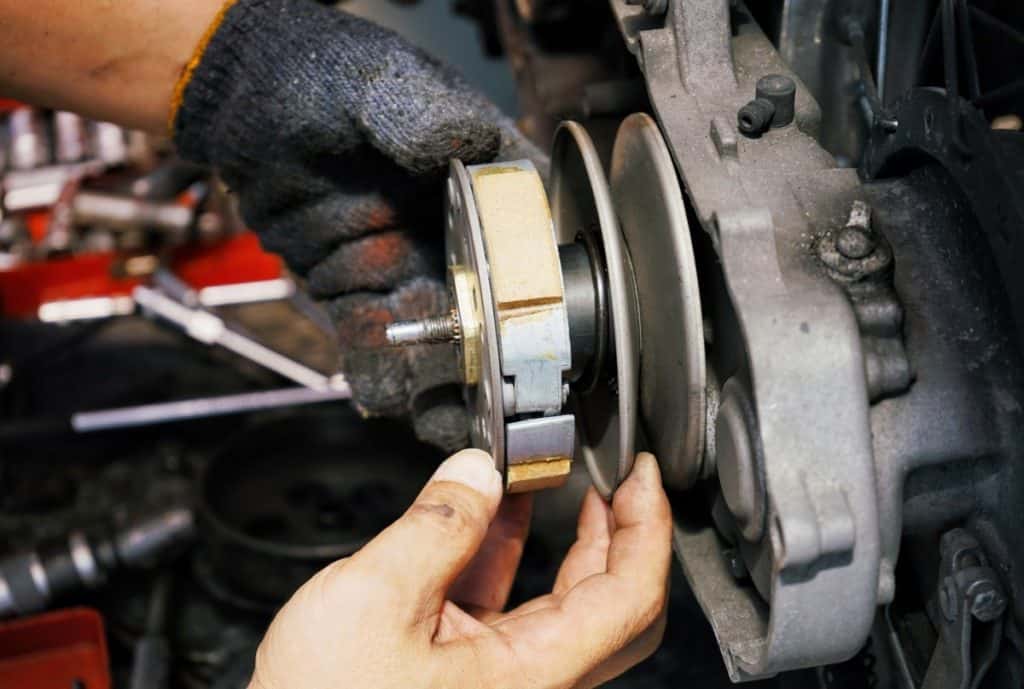The clutch is one of the most important aspects of a motor. Doing routine maintenance on a clutch is recommended every 6 to 12 months by most ATV manufacturers. Today, I will explain how to tell if your clutch is bad and needs to be repaired or replaced.
When you accelerate the engine will rev but it won’t accelerate very well or at all. This can happen the whole time you accelerate. Or, it can catch, slip, and then catch again. This occurs because the teeth of the discs are worn and do not lock into place to turn the drivetrain.
The exact amount of time a clutch can last varies based on how your ATV is ridden. For example, if you ‘ride the clutch’ it will cause significantly more wear than if you don’t do so. In this article, I will explain whether you can fix a slipping clutch without replacing the whole clutch, what happens if you continue to drive with a bad clutch, and how to check the life of your clutch.

Can You Fix a Slipping Clutch Without Replacing It
In general, it’s best to replace a slipping clutch. But, a slipping clutch isn’t always caused by a worn clutch. It can also be caused by the misadjusted clutch lever and cable. The clutch is engaged by squeezing on the lever on the handlebars. If the cable is too loose or too tight it can not engage the clutch correctly.
Here’s a video that shows how to adjust the cable on a Honda ATV. But, the process is very much the same on all ATVs. Also, it explains when to replace the clutch cable.
Adjusting the cable should be your first check if your clutch is slipping because it’s far easier than replacing the entire clutch. If the cable is perfectly fine then it isn’t possible to fix a slipping clutch and virtually all mechanics recommend replacing the entire clutch.
It’s quite an involved job, so you may decide to have a mechanic do the job for you. ATV brands generally have certified technicians that can do the repair for you. However, it can save you quite a bit of money to do it yourself provided you’re confident you have the skills and tools to do so.
Here’s a very good video that shows step by step how it’s done, so you can get an idea of whether you’ll be able to do it yourself or not.
Will a slipping clutch fix itself
A slipping clutch is a symptom of the teeth being worn. When you engage the clutch it releases the teeth, and when the clutch is let out the teeth grip again turning the drive shaft which turns the wheels. Because the teeth are worn a clutch won’t fix itself. Therefore, when it starts slipping the only way to get it to stop slipping is to replace the entire clutch. A whole new clutch costs in the range of US$500 depending on the make and model of the clutch. As well as, the cost to do the repair.
A worn clutch is considered normal wear and tear and is not covered by an ATV warranty. An ATV warranty only covers if the part fails early. So, it’s worth looking into if your clutch fails much earlier than 50,000 miles (80,000 km).
Which is about average for an ATV clutch. There are a range of factors that can decrease the life of the clutch of an ATV, which aren’t necessarily common knowledge unless you’re a mechanic, or tinker around on the engines of cars a lot.
How to reduce wear and tear on a clutch
According to National Transmission a transmission repair and replacement company based in Canada the following are a list of don’t to increase the life of your clutch:
- Don’t ride the clutch
- Don’t leave it in gear on a hill, instead use the handbrake
- Don’t keep the clutch engaged for long periods of time, such as when you’re stopped
Riding the clutch is where you accelerate while the clutch is engaged. A certain amount of this is necessary to stop the engine from stalling. But, you should aim to do it the least amount possible.
When you park your ATV is can happen that you need to leave it on a hill for a certain amount of time. According to the popular ATV owners manuals, you should avoid this as much as possible. However, in the case where you do, don’t leave your ATV in gear, and instead, use the handbrake.
It’s is a known additional fail-safe in case the handbrake fails, however, it does increase wear and tear on the clutch. When you’re stopped and idling your ATV aim put it in neutral rather than keeping the clutch engaged to stop the engine from stalling.
Also, aim to use the clutch the least amount possible. For example, when you slow down try not to shift down gears unless you absolutely need to.

What Happens if You Keep Driving With a Bad Clutch?
When a clutch begins to slip it’s a sure sign that the clutch can be going bad. Although, this can also be caused by the clutch leaver or cable. Here’s what happened if you continue to drive with a bad clutch.
A clutch that is already bad will continue to get worse over time. Eventually, you won’t be able to move the vehicle at all. This is because the clutch will permanently slip and won’t engage at all. It can last for some time, but it can be dangerous if it slips at a time that can cause an accident.
Therefore, for your own safety, it’s best to replace a bad clutch as soon as possible. For example, you might be accelerating up a hill, and the clutch slips, and you begin going backwards down the hill.
How Do You Check Clutch Life?
Checking the state of the clutch is recommended the first month of a brand new ATV, then every 6 months, or 12 months after that. The life of a clutch can vary based on how it was used. So, I’ll explain how to check the clutch life for your clutch.
In general, there isn’t any way to see how long it will last unless the clutch starts to slip. A clutch will last on average 50,000 miles (80,000 km) but depends on how much the clutch is used. The only sign it’s nearing the end of its life is when it begins to slip.
The owner’s manual of most ATVs provides guidelines for when a clutch should be serviced. This generally involves disassembling it and cleaning it out. I’ve looked at the owner manuals for the top ATV brands such as Polaris, and Yamaha and noticed they don’t provide any details for how to service it.
So, below I’ve included a really good video that explains the top ways to maintain your ATV clutch with detailed step by step instructions:
